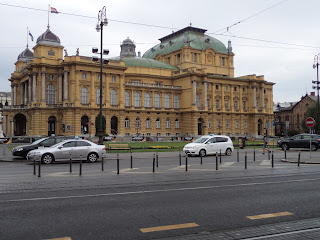Wednesday 14th June, 2017
Zagreb
My goodness, I seem to have got everything to work!
Today we woke to gloomy skies and, just as we set off for our tour of Zagreb, the rain started. It got worse before it got better!
Today we woke to gloomy skies and, just as we set off for our tour of Zagreb, the rain started. It got worse before it got better!
Zagreb is distinguished by its 18th- and 19th-century Austro-Hungarian architecture, of which this is a good example - this is the National Theatre.
Shortly after we passed this building, the rain came down in torrents. I had an umbrella, but other people has neither umbrella not raincoat, and we had to make an unscheduled umbrella buying stop. Paul had to buy an umbrella! After that, we pressed on to the old part of the town.
The first recorded appearance of the name Zagreb was in 1094, at which time the city existed as two different city centres: the smaller, eastern Kaptol, inhabited mainly by clergy and housing Zagreb Cathedral, and the larger, western Gradec, inhabited mainly by craftsmen and merchants. Gradec (now referred to as the Upper Town) can be reached by a funicular which was unfortunately not running today, so we were obliged to climb a great many steps instead. Gradec was fortified, and this is a watchtower remaining from the fortifications.
A small cannon protrudes from a window on the fourth floor, and it is fired at noon. We weren't there to hear it, unfortunately.
St Marks Church is the parish church for this area, and the original church dates to the 13th century. It has been reconstructed several times.
The colourful tiles on the roof are orange, blue, white and black. The left hand illustration represents Croatia in three parts, Croatia, Slavonia and Dalmatia. On the right is the coat of arms of Zagreb. The church is flanked by a government administrative building on one side and the Parliament building on the other side.
From there, we walked down a slope towards the Kamenita vrata, or 'stone gate', which originally formed the main eastern entrance to the town. Inside the gate – which is really more of a long curving tunnel than a gate – lies a very popular shrine, a sixteenth-century icon of the Virgin in a grille-covered niche. Miraculous powers have been attributed to the statue, largely on account of its surviving a fire in 1731. There were quite a few passing city folk offering a quick prayer; I spotted one lady with a candle, and later, a man kissing the grille.
Once through the tunnel of the gate, you continue to descend the slope and find this statue of St George.
Actually I think the dragon looks more like a catfish!
Below St George is a street our guide said had been a popular medieval shopping street.
At the foot of it we came to a street that had once been a stream and marked the boundary between Gradec and Kaptol. One old building opposite had been a medieval brothel.
We climbed up towards Kaptol, making a stop at the market for a quick look round - and a quick coffee on my part, as my back needed a rest. Then we headed on up to the cathedral.
The cathedral is almost wholly neo-Gothic, having been rebuilt by Viennese architects Schmidt and Bollé after a catastrophic earthquake in 1880. They are also responsible for many other buildings in Zagreb.
Kaptol was also fortified, though little evidence of this remains, just this tower and a small section of wall.
Our last visit was Governor Jelačić Square, or Trg bana Jelačića, a hectic place full of cafés, hurrying pedestrians and clanking trams. It’s apparently the biggest tram stop in Zagreb, at the intersection of seven cross-town tram routes, so it's always busy and noisy.
At its centre is the equestrian statue of the nineteenth-century Ban of Croatia, Josip Jelačić, who won some autonomy for Croatia in the late 1860s. The square was renamed Trg Republike in 1945 and the statue – considered a potential rallying point for Croatian nationalism – was dismantled after the war in 1947. Its parts were stored away until 1990, when it was restored to the square, although it now faces in a different direction.
I managed to photograph it with a pigeon sitting on the feather on the general's hat!
Paul and I went back to the hotel for a rest, and later retraced out steps so as to have a closer look at many of the things we had seen earlier in the day. We also took the opportunity to visit the Museum of Naive Art, which is situated close to St Marks Church. This necessitated a second climb up the steps to the Upper Town as the funicular was still not working!
We enjoyed the little museum which exhibits works painted mostly in the last century by completely untrained 'Sunday painters', many of whom were peasants. The paintings were hard to photograph because many of the painters were too poor to buy canvas and painted on odd pieces of glass, and the reflections don't make for a good photo.
This is one I particularly liked, called 'Cows Hauling Wood', painted in 1965 by Ivan Večenaj









No comments:
Post a Comment